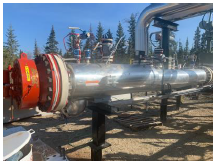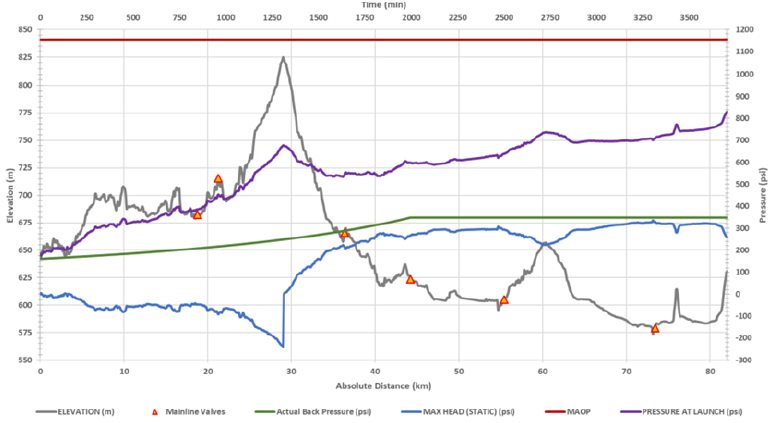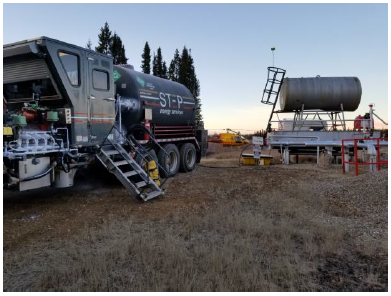An Alberta pipeline system that was successfully commissioned, relied on STEP Energy Services for technical support in its safe and predictable start-up. The system consisted of two parallel lines flowing countercurrent – one line delivering condensate and the parallel line delivering crude oil. STEP was chosen to support this important commissioning based on safe work procedures, personnel experience in pipeline commissioning and engineering simulation techniques that predicted the control of the gas/liquid interface during line fill.

Discussion
The commissioning of pipeline systems takes special consideration in safely filling and landing the pipeline hydrocarbon product to its destination. The prediction and control of the liquid/gas interface of a new system is paramount to delivering the fill at the receive point in a state that minimizes energized hydrocarbons that can result from entrainment of gas into liquid during the commissioning.
Entrained gas in hydrocarbon at the interface pig can occur when insufficient backpressure is provided during the fill and the weight of the liquid column descending elevation causes the column to break and create an undesired vacuum effect; gas ahead of the lead pig can entrain into the liquid creating energized fluid due to pressure and finely dispersed gas bubbles.
Receiving energized hydrocarbons creates severe control and handling problems, particularly in tankage due to foaming of the hydrocarbon which can break tank roof seals or cause uneven floating of the roof top resulting in leakage. Larger gas bubbles dispersed in hydrocarbon transitioning from pipeline pressure to lower tank pressure can result in accelerated velocity often in the range of static electrical generation.

A carefully thought-out line fill plan will minimize occurrence of fluid column break, gas energized hydrocarbon or liquids ahead of the interface pig. Additionally, the plan will guide the pipeline operator to crucial pressure/chainage points where pre-determined back-pressure must be developed to tightly control the liquid column in dynamic condition particularly in elevation decent. With the application of task and flow modelling, the engineered fill program is capable of discrete adjustments to program that account for changes in elevation, fluid characteristics, flow rate, temperature, valve location and type, and receive point characteristics.
Input to the execution plan for line fill must take into consideration the main line valve control characteristics and by-pass, pipeline wall thickness changes, system pressure and flow indicators, pig signal devices and the receive point of the hydrocarbons. Careful planning must be given ahead of time to the landing of hydrocarbons with a specific plan to de-energize hydrocarbons prior to receipt to storage; the safe and environmentally sensitive treatment of venting pipeline backpressure gas and energized hydrocarbon off-gas requires experience and engagement with the various system owner stakeholders.
STEP Energy Services – Leadership in Pipeline Commissioning
STEP Energy Services safely commissioned a new parallel pipeline system in Canada; the attention to operational conditions and predictable line fill plan through tailored engineering simulation provided the platform to confidently execute this program.
With the new parallel pipeline system nearing completion of construction, STEP engaged with the operator to review critical details of the 82 kilometer system (as-built), and designed a line fill program for both unique pipeline systems (condensate and crude oil). The challenges of this system included multiple, and significant elevation differentials of up to 150 meters as well as remote locations of main-line valves with no by-pass.

The application of nitrogen for back pressure control is a strength of STEP Energy Service. As an industry leader in nitrogen pumping, STEP judiciously applies the inert gas in back pressure control programs to result in a tight liquid column back, and most importantly a safe atmosphere when hydrocarbon batches are landed.
Economic evaluation of the back pressure control program by STEP allowed discussion with the operator to consider the use of key main-line valves for segmentation of the pipeline system which reduced the nitrogen gas volumes by 60% for critical pressure/chainage points. STEP’s attention to detail included an understanding of operator valve locations, and method and timing of valve swings.
STEP conducted a thorough analysis of the parallel pipeline system which runs counter-current flow and recognized the opportunity to conserve resources by routing back pressure gas from one system into the second system. This decision positively impacted the project from an economic perspective by reducing both the costs to treat vent gas as well as the cost of inert nitrogen gas required for safe backpressure/atmosphere control. Thorough attention resulted in a 10 per cent savings of nitrogen gas for back pressure control on the second pipeline, which also carried additional savings in personnel and equipment time that would otherwise have been used in venting of the first system.
After careful analysis of elevation profile and fluid characteristics, STEP worked closely with the operator on line fill rates and optimization of their commissioning schedule by calculating the friction forces of the line fill and elevation pressure forces to overcome and relate this detail to the capability of the system pump during the commissioning phase. This detail allowed the operator to confidently plan its schedule for shippers on the system and personnel required on the system for commissioning activity.
Understanding all forces that can affect the available pump energy during commissioning of the pipeline, STEP worked closely with a specialty pig manufacturer in the supply of fit-for-purpose batch pigs for each line and hydrocarbon characteristic; the goal was to apply a well-sealing pig that resists back pressure gas from passing the interface pig into the hydrocarbon batch while at the same time providing characteristic of low pressure requirement in dynamic state.
STEP Energy Services – Importance of a Well Designed Commissioning
Bringing a pipeline system into operation is a step that requires attention to detail and early engagement with a trusted service provider. The key contributing pressure forces to line fill are elevation profile, pumping rate and receive point; detailed evaluation of elevation is the single most important consideration of an engineered plan. Understanding the weight of a liquid column in dynamic operating conditions as it descends elevation peaks, allows for back-pressure control design that keeps the liquid column tightly packed without entraining gas into hydrocarbon. If back-pressure is insufficient, a break in the liquid column can occur resulting in a vacuum being formed within the liquid column. If back pressure is too high, gas can entrain in the hydrocarbon phase by passing over the interface pig; additionally the line pump may become ineffective at filling the line if back-pressure is too high, which can result in inefficient use of resources and time.

The venting of backpressure gas and control of its pressure during the line fill must be carefully designed to allow discrete changes to back pressure at key points of pipeline chainage. The venting of backpressure gas must be analyzed and understood relative to the gas type, vent size, control valve type, choke and gas velocity. The design of the venting program and use of pressure tanks, vent silencers, gas scrubbers and flares requires thorough analysis and early discussions with the operator stakeholders.
For an engineered solution to your upcoming commissioning / decommission opportunities, please contact STEP at one of the following facilities:
https://www.stepenergyservices.com/
Fort St. John, BC
6711 87A Avenue
Fort St. John, BC
V1J 0B4
Phone: 250-787-8812
Dispatch: 1-855-480-STEP (7837)
Grande Prairie, AB
10202 88 Avenue
Clairmount, AB
T8X 5G8
Phone: 780-830-0684
Dispatch: 1-855-480-STEP (7837)
Red Deer, AB
30 Burnt Bluff Street
Red Deer, AB
T4P 0J6
Phone: 403-406-6002
Dispatch: 1-855-480-STEP (7837)
San Antonio, TX
70 NE Loop 410
Suite 1070
San Antonio, TX 78216
Phone: 210-477-1517
Share This:





 CDN NEWS |
CDN NEWS |  US NEWS
US NEWS 






























